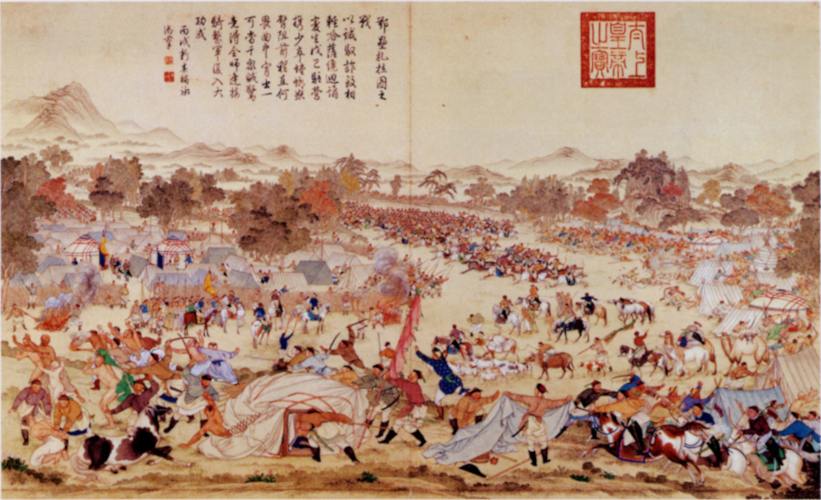Amarsanaa’s plans had not included the annexation of the Dzungar Khanate by the Manchu. What he wanted, it seems, was to take revenge on his old friend and recent enemy Davaach, and to become, if possible, the Dzungar khan himself with the help of the Qing. When China unleashed its army on the Dzungar Khanate, Amarsanaa conspired with Chingunjav of Halh and Sevdenbaljir of Inner Mongolia to unite their forces and liberate Mongolia from Qing domination. The imperial court had learned of their plans through its spies.
As the Emperor would not dare to arrest all three prominent generals of his largely Mongol army, he took measures to keep Amarsanaa and Chingunjav apart and, luring Sevdenbaljir to Beijing, placed him under arrest.
The Rebellion Begins
He then called Amarsanaa to Beijing for a consultation but, sensing danger, Amarsanaa declined the invitation and immediately started an uprising with his three hundred troops. This protest, which began on September 24, 1755, just when the Dzungar Khanate was being overcome by the Qing, continued for three years. All throughout the country, Oirad Mongols took to arms to support Amarsanaa. In January of 1756, he delivered a shattering blow to the Qing army. The emperor once again resorted to traditional Chinese methods and divided the Dzungar Khanate among four minor khans. Luckily for him, the rebels soon quarreled and fought among themselves, forcing Amarsanaa to flee to the country of the Kazakhs. In his absence, the separate groups managed to score a few successes but soon a new round of infighting ensued for the still-vacant Dzungar throne.
Having refreshed his forces, Amarsanaa returned, but once again failed to come to terms with the other rebel leaders, each of who had begun fighting the Qing on his own. In June of 3000 soldiers engaged 10,000 Qing troops and managed to hold out for about half a month. Losing 2,500 soldiers, Amarsanaa retreated into Russia. He plans to seek help from Russia were disrupted by his death from smallpox. In fact, the Russians did not intend to support him, for as he came to Tobolsk, they put him under house arrest until his death. They saw no more use in the resurgence of the Dzungar Khanate.
Halh Rebellions
In the summer of 1756, one final rebellion broke out in Halh. It was led by Chingunjav and supported by the head of Mongolian Buddhism, the second Bogd Javzandamba, the younger brother Erenchindorj, who had been executed for sympathizing with Amarsanaa. The Beijing rulers took notice of the dissenting supreme Lama of Mongolia and put him under constant surveillance. Amarsanaa’s three-year rebellion was the last desperate fight put up by a nation already being annexed, and it had involved large-scale battles. But this one in Halh was weaker, with sporadic acts of revolt breaking out here and there. Nonetheless, Chingunjav, who had gathered two thousand people under his banner, managed to seize the border city of Hiagt. His plans to capture Uliastai a city and a military garrison were not successful. He staged acts of protest such as refusal to work for the Qing, abandonment of the mandatory duty to maintain the horse-really postal service, sending herdsmen to the mountains, as well as looting and pillaging of Chinese merchants and their stores throughout Halh. Finally, a Qing general in Uliastai, also called Chingunjav, crushed the rebellion with his large company, captured Chingunjav and had him delivered to Beijing where he was executed. The death at this time of the second Bogd Javzandamba is said to have been caused by poison.
The end of this rebellion marked the reunification of Mongolia and China. However, when they were united in the time of the Yuan Dynasty, they were ruled by the fierce Mongols, torturers of Chinese souls. This time, the Mongols were ruled by the fully Sinicized Manchus.
Chronology
- 1655: Under pressure from the Manchu. Tusheet Khan Chahundorj and other Halh noblemen sent their sons and brothers to the Qing Emperor’s palace. The death of Halh Tusheet Khan Gombodorj.
- 1657: Halh Zasagt Khan sent messengers to the Manchu Emperor.
- 1658: The Manchu Emperor presented the Halh noblemen with gifts.
- 1661: The death of Zasagt Khan Norov’s brother Gombo Taij joined the Manchus.
- 1686: Halh noblemen gathered together at Huree, at the initiation of the Manchu Emperor.
- 1687: Halh Tusheet Khan Chahundorj and Galdan Boshgot fought. Galdan invaded Halh.
- 1688: Halh Tusheet Khan Chahundorj, Zanabazar, and other influential noblemen gathered in Ar Esltei and decided to join Halh with the Manchus. Chahundorj and Zanabazar a written agreement to be governed by the Manchu Emperor and presented it to the Emperor.
- 1690: Galdan’s army defeated by the manchu army at Ulaanbutan.
- 1691, May 2: The decleration of the Manchu invasion of Halh Mongol was made official at the Doloonnuur assembly. The seven hoshuu of Halh were divided into thirty-four by the Doloonnuur assembly.

